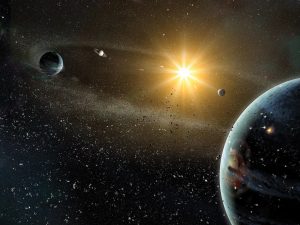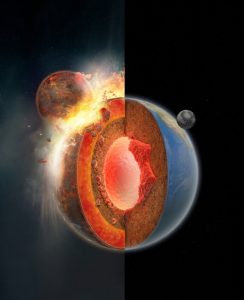
Sometimes, our place in the universe really messes with our ability to understand the universe. From wanting life to be Earth-like, to wanting alien solar systems to look like our solar system, it turns out our wants can bias how we try to science reality. And this means that sometimes our theories are just run.
Folks, our theories for how solar systems evolve just keep turning out to be flawed.
It all started with the Solar Nebula model, which was put forward in 1755 by Immanuel Kant. A natural philosopher with a strong grounding in science, Kant reasoned that our solar system formed through the collapse of a massive cloud of material that began to spin faster and faster as it condensed and flattened. In the heart of this solar nebula, the sun would form, and in that disk, we’d find planets getting their start.
And that part of the theory – the part dating back to 1755 – appears to be true. It’s what came after it that caused us problems.
As telescope technology advanced, and our cataloging of the contents of our solar system got more detailed, researchers began to build a picture of planetary formation that had our worlds – the major planets and the minor bodies – all forming pretty much where we find them today. Rocky worlds, it was told, would form snuggled up next to their Suns, while the gas giants would favor farther regions and the ice bodies would orbit in the great cold beyond. It’s a pretty story. It does a great job describing the solar system we live in… but towards the end of the last century, we started noticing some issues.
For instance, if everything politely formed in situ, why do we see evidence that from about 3.8 to 4.1 billion years ago, the sky was falling in the form of asteroids and comets smashing violently onto the surfaces of world after world?
We also saw chemistry that didn’t quite seem to line up and other little things that all added up to a whole lot of, “What are we missing?”

And then, in the 1990s, we started finding planets around other stars. The first discovery of a rocky lump orbiting a left-behind pulsar in a system that had experienced a supernova. That was easy to explain as “Not something our theories had considered.”
But the next discovery – a world half the size of Jupiter with an orbit less than a tenth the size of Mercury’s – everyone agreed that gas giants aren’t supposed to be in the inner parts of a solar system and astronomers found themselves trying to figure out how to move planets around to make sense of our latest discoveries.
And we did pretty well with a new theory introduced in 2005 — the Nice Model. Developed by a group of planetary scientists meeting in the city of Nice, France, this theory imagined our early solar system as a place where everything was on the move up until the bulk of the leftover bits of solar system formation were cleared out. Essentially, the planets formed in a disk, just like before, but this time about 35 Earth masses of material were scattered amongst all their orbits — orbits that were imagined to be a bit more compact and a lot less permanent.
As the leftover material interacted with the planets, especially the gassy worlds that migrated outwards as rocky bodies got thrown inwards. The rocky planets got beat up, creating the craters we associate with the great heavy bombardment. This all culminated, so the story goes, in Jupiter and Saturn ending up in a resonance, and flinging other worlds and pretty much all the remaining rocks to and fro.
And the theory is sound until you ask, “But why didn’t the planets fling rocks both inward and outward?” Models done by the likes of Kevin Grazier show Jupiter is an equal opportunity flinger of rocks.
The theory also breaks down when you look at some of the data of the last ten years.

Since 51 Peg was discovered in 1995, we have found more than 5,000 worlds orbiting other stars in myriad configurations thanks to missions like Kepler and TESS. We’ve also been able to capture images of solar systems in a variety of different stages of formation using systems like the Atacama Large MM/Sub-MM Array and the Very Large Telescope in Chile, as well as the Hubble Space Telescope. The combined reality of all these systems shows us that planets can and will form just about anywhere, and we somehow have to figure out how that happened. We find systems with massive disks; we find systems where stars rapidly blast away their disks. We find just about everything except a twin to Earth and planets between 1.5 and 2 Earth masses. Can I tell you why? No. No, I can’t.
It is now looking like planets can migrate in or out, and planetary formation has to happen faster than we previously thought to allow massive worlds to form before their stars blow away all the gases that build their beautiful atmospheres.
And, I have to admit I find a lot of comfort in knowing that the formation of a solar system isn’t so simple that Kant figured it all out in 1755. Solar Systems are the places where we expect life to evolve, and I want that Star Trek universe of myriad life forms that have each to be happy on their own strange new worlds.

While our big picture on planet formation still has problems, one good thing we learned is worlds will go smash. Like we see what appears to be debris clouds in other star systems of worlds that went smash with almighty debris-making force.
And this is important because it means we actually do understand where our Moon came from. The Moon has been observed to be slowly moving away from Earth since the 1960s. This observation gave strength to a 1946 theory, from Reginald Daly, that the Moon was created during a massive impact. Further work by Bill Hartman and Don Davis showed how this kind of event could lead to an Earth and Moon with different densities that reflected a massive collision and splattering of debris. Researchers who compared Apollo Moon samples with this theory’s predictions ended up agreeing: a great impact between some Mars-sized world – posthumously named Theia – and a younger and smaller Earth seems to have produced the modern, denser Earth and our shiny Moon.
But this raises the question: did all the splashy bits really become the Moon? Could there be meteors and tiny asteroids all over that were also formed in that impact? In a moment of what I thought could be cleverness, I even wondered if rubble pile asteroids could form in this kind of event. They can’t by the way.
After decades of looking at the chemical composition of all sorts of meteorites, it appears the Moon-forming impact didn’t fling debris everywhere… at least not debris that later returned.
But while meteorite researchers were failing to find pieces of Theia that had fallen back out of the sky, earthquake researchers were finding continent-sized pieces hiding out inside our planet.

It turns out, there are two roughly Moon-sized chunks of material hanging out at the core-mantel boundary inside our planet. One is beneath the African continent while the other is beneath the Pacific Ocean. These regions have a different density than other material at this depth, and they alter seismic waves as they flow through our planet. Discovered in the 1980s, these blobs perplexed researchers for 40 years. Then, one day, geophysics student Qian Yuan heard planetary scientist Mikhail Zolotov discussing the giant-impact hypothesis and, according to Yuan, “Right after Mikhail had said that no one knows where the impactor is now, I had a ‘eureka moment’ and realized that the iron-rich impactor could have transformed into mantle blobs.” Yuan did the work, ran the simulations, and demonstrated for the first time – because computers were finally good enough to demonstrate it – that it’s possible for chunks of the impactor to survive inside our world.
This is your friendly reminder – astronomy advances at the pace of technology, one creative individual at a time.
The idea of worlds in collision is perhaps as old as the concept of worlds. If you want to imagine a romp through the solar system of a fragment of a disrupted planet Earth, you need go no further than Project Gutenberg. Available for free, Jules Verne’s “Off on a Comet” offers an 1877 imagining of what could happen if a chunk of our world were knocked free. This story does suffer from the social norms of France in the 1870s, but the science is surprisingly well thought out.
While still under copyright, Immanuel Velikovsky’s 1950 book, “Worlds in Collision” is easy to find in the used book market. Written as a scientific treatise, this book is better seen as a creative work. Velikovsky summarizes, “Worlds in Collision is a book of wars in the celestial sphere that took place in historical times. In these wars, the planet Earth participated too. […] The historical-cosmological story of this book is based in the evidence of historical texts of many people around the globe, on classical literature, on epics of the northern races, on sacred books of the peoples of the Orient and Occident, on traditions and folklore of primitive peoples, on old astronomical inscriptions and charts, on archaeological finds, and also on geological and paleontological material.”
If you want to imagine our solar system at its wildest and most impossible, catch this historic fiction and know that while these authors got things wrong, we still don’t actually have all the answers… and that’s why we’ll keep doing science.
